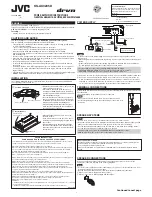
10
En
Quick Start Guide Part1
Home Theater: The Basics
Most consumers are used to using stereo equipment to listen to music but many people are not used to home theater
systems that give you many more options when listening to soundtracks. In fact, home theater is not really
complicated and this little guide should give you an understanding of the basics.
The main reason why it seems so difficult is that there are three different factors involved in home theater and each
will contribute to what kind of sound you get.
These factors are:
1) The equipment you are using for your home theater setup. Particularly important is the number of speakers you are
using. We call this your speaker configuration.
2) The 'source' material you are using. This is the actual product (like a DVD) or broadcast (like cable TV) you are
listening to/watching. We call this the source.
3) The last factor is the listening mode you choose on the VSA-AX10i-S amplifier. These are explained below and in
subsequent chapters but most likely the STANDARD (default) setting will be fine.
Let's start with the home theater setup you have in your home.
1) Your Home System
The heart of your system is the VSA-AX10i-S amplifier and it is very flexible in getting you theater-like surround sound.
You can use this amplifier with anywhere from two to seven speakers (front left, front right, center, surround left and
right, and surround back left and right) and a subwoofer to get home theater surround sound. We recommend you use
seven speakers and a subwoofer. If this is not possible follow the instructions in "Auto Surround Setup" in the "Quick
Start Guide" and you will be able to get good surround sound. Also, a DVD player is essential for home theater and you
can also hook up satellite or cable TV tuner to this amplifier and get a more home theater-like sound from these
sources.
2) The Source Material
DVDs have become the basic source material for home theater because they offer excellent sound and picture quality,
and allow users to enjoy home theater soundtracks with more than two channels of audio. For example, Dolby Pro
Logic plays back four channels and Dolby Pro Logic 2 five channels. Originally Dolby Digital, MPEG and DTS sources
usually have six discrete channels (front left, front right, center, surround left and right and a channel that powers the
subwoofer) of sound. Since the subwoofer channel is only for bass sounds, this multichannel setup has been named
5.1 channel sound. The new Dolby Digital Surround EX and DTS-ES formats added surround back channels to the
above configuration and now provide 7.1 channel sound.
It is important you consult the manual that came with your DVD player as well to make sure the player is outputting a
surround soundtrack and all the other settings are appropriate for your home theater.
3) The Listening Modes
This amplifier has many different listening modes and they are designed to cover all the speaker configurations and
types of sources you might be using. In general, if you follow the recommended advice and have seven speakers and a
subwoofer hooked up, in most cases the STANDARD listening mode is the easiest way to get realistic home theater
sound. This is the default setting so you don't have to do anything.
To listen to music in stereo simply choose the STEREO listening mode. Other possibilities (like listening to a stereo CD
with all seven speakers or taking a stereo source and getting multichannel home theater-like sound) are explained in
listening modes (pages 53–57).
Conclusion
These are the three basic factors that contribute to your home theater sound. The easiest thing is to hook up seven
speakers and a subwoofer and simply play your DVDs with STANDARD 7.1 (default) mode. This will give you realistic
and enjoyable home theater sound. First hook up your equipment, like your DVD player, TV and speakers. Then follow
the instructions to set up your system for surround sound. It is very important you do one of the surround sound setups
to get optimal sound from your amplifier.
For more details on any of the information presented here check the main section of the manual.











































